For a few years now, faced with the progression of audio downloads and people listening to them on computers, a number of small, mostly unknown manufacturers have rushed into the market for standalone digital to analogue converters. The major audio and audio-video players, especially the Japanese, seem to have held off (either through cautiousness or slow reactions, or perhaps both).
Now Denon have appeared with their first DAC unit, the DA-300USB, a handsome piece of equipment which can be used in its classic horizontal pose or stood on its side (next to a monitor for example) thanks to a base which slips on and locks into place.

Inside the DAC is the system known as Advanced AL32 processing, which converts all digital inputs from 32-bit to 192 kHz, and which has been a feature of the brand’s CD players for a number of years.
Alongside an asynchronous USB port, which accepts all signals from 24 bits to 192kHz and DSD64 signals, the DA-300USB also features three S/PDIF ports, two optical and one coaxial.
The output line is fixed and features a 6.35mm jack with a volume control and its own amplifier. Let’s take a closer look at the DA-300USB:

Overview
Denon have always stuck to a certain classic aesthetic with Hi-Fi equipment so there’s almost something a bit audacious about the DA-300USB with its silver casing, fitted black plexiglas front, and lightly curved sides.
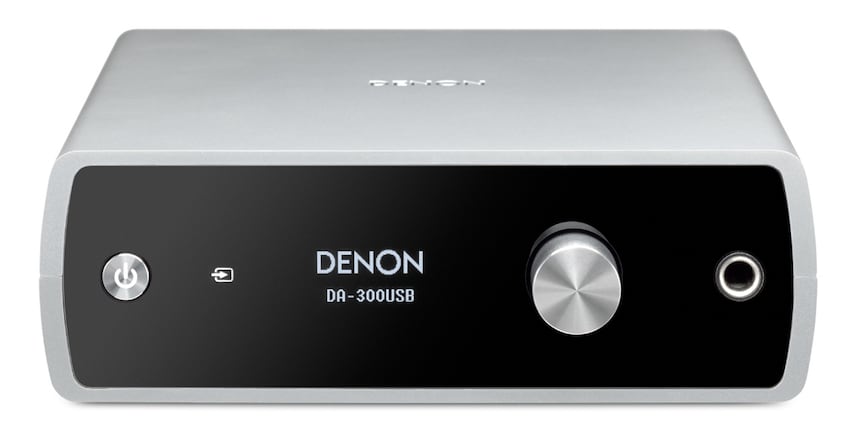
All the way on the right, the power button sits next to the backlit retro-looking tactile source selector, and next to that a display indicating the source with a name and an icon when you select it, which is then indicated solely by the icon. The two lines at the bottom show the sampling rate and the volume from -95 dB to 0 dB by 1 dB steps, with the bottom of the range (no sound) represented by three dashes.
The display adapts to the horizontal or vertical position of the DA-300USB. The volume button is a rotary encoder and the headphone output is the standard 6.35mm Jack.
Connections
There are three S/PDIF inputs (two Optical and one coaxial) plus the USB, which is decent, while there’s just one output, via stereo RCA.
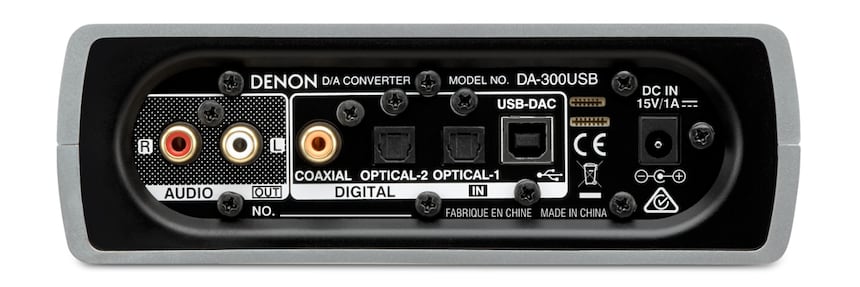
The external power is pretty high in both voltage (15 V) and current (1 A). So what’s under the bonnet?
Build Quality
The interior is clean to look at, with the wiring made pleasantly minimalist. The structure is actually pretty clever with an internal framework closed off by two resin shells, each one with its own sheet of 3mm galvanized steel designed to protect against interference. They also add a nice bit of weight and stability when the DA-300USB is used on its side.
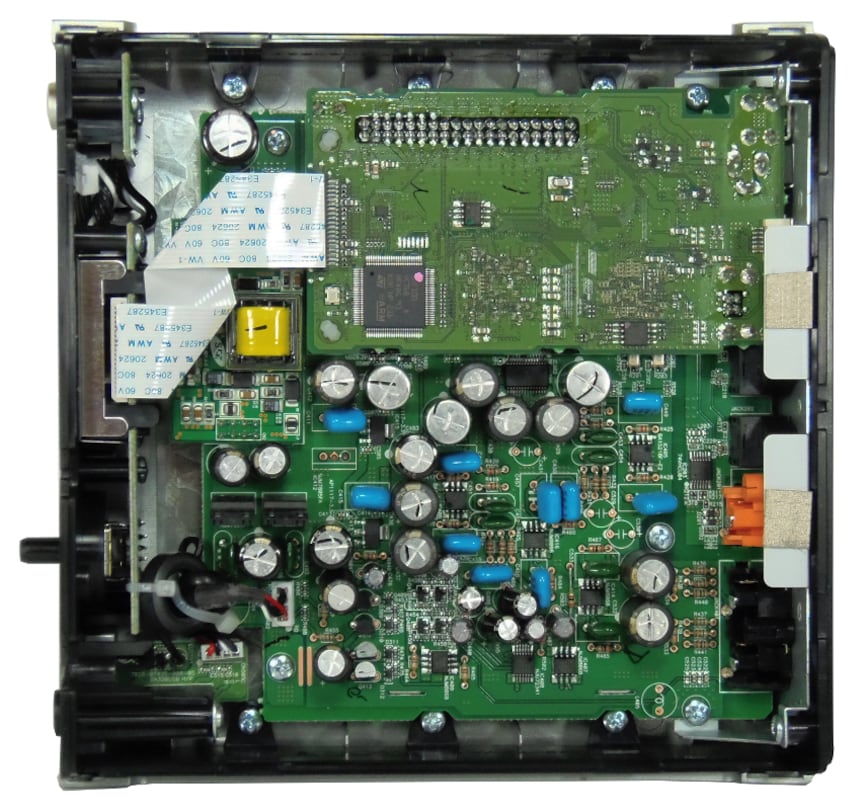
The USB port has its own circuit, which is joined to the main board via a multipoint connector. It also carries the 15 V voltage from the power supply, which is then converted into two separate currents by a switched-mode power supply (also on the main board) which seems to have a large enough transformer to provide plenty of juice.
Along the front there are two other circuits, one for the power button and the other for the display and the optical encoder (which counts the pulses from a switching light beam: no wear and tear likely here).
Power
It must be stated first of all that the digital inputs, both the USB and the S/PDIF are totally electrically isolated (by galvanic isolation) from the rest of the DA-300USB’s electronics. This means there’s no risk of interference when another device or computer is linked up. It’s almost completely certain to eliminate problems like ‘ground noise’.
The signals, which are processed by the USB card, are also isolated by Analog Devices ADUM1285CRZ (Dual channel digital isolator) circuits, which guarantee voltage isolation up to 3 kV!
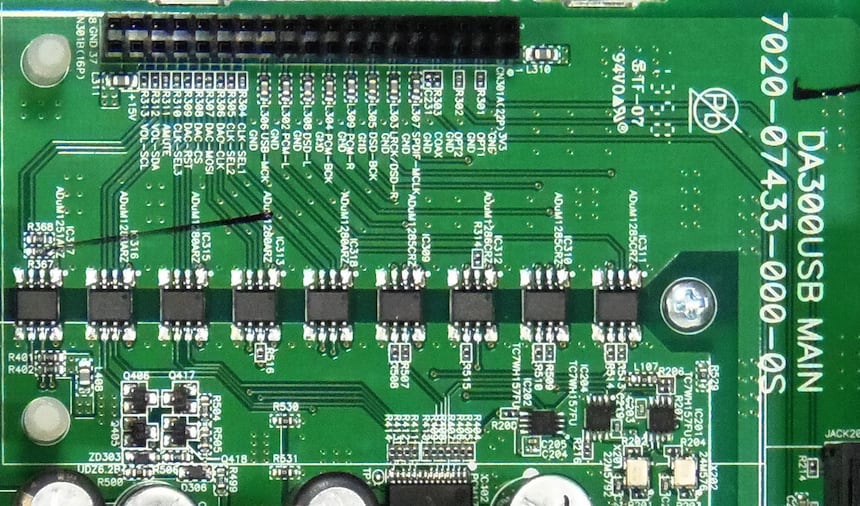
As for the power, the symmetrical voltages (+ 11V and -11V) coming from the switched mode power supply have their own LM7809 and LM7909 linear regulators which provide a regulated current of + or - 9V for the analogue part of the circuit.
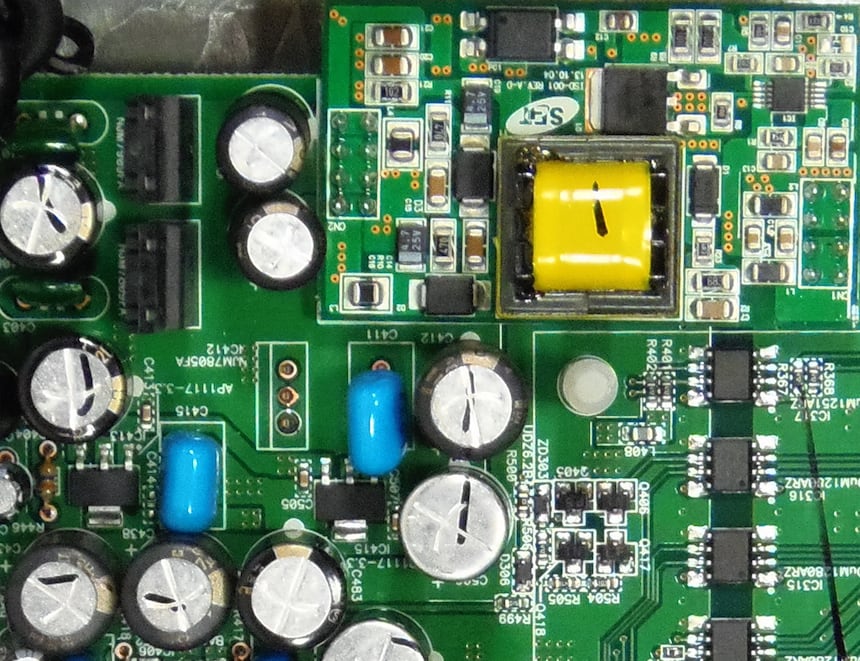
The positive current of 11V also provides the necessary power for the logic circuits and the digital to analogue convertor, namely +5V with a LM7805 integrated regulator, which in turn feeds an AP1117-3.3 regulator which provides 3.3V.
There are also a number of electrochemical capacitors linked to the regulators, some manufactured by Elna.
USB and S/PDIF Interface
This interface sits on a dedicated card covered with components on both sides. The open face (left side of the image below) holds the ST32F100 microcontroller from STMicroelectronics as well as the 25L4006 Flash Memory.
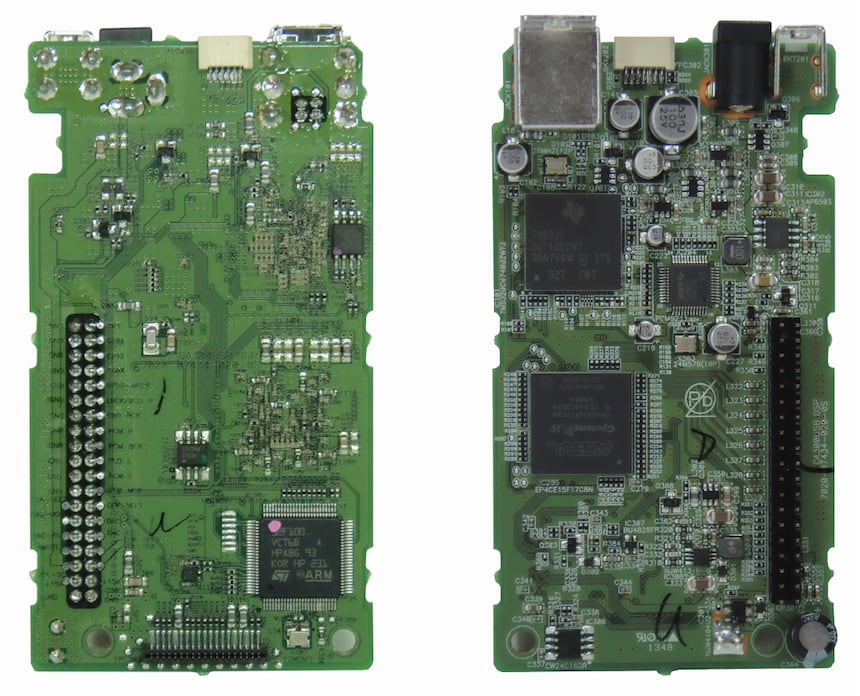
On the underside, visible in the right hand side of the photo above, are the electronic interface and the digital audio signal processing.
Next to the power socket is an AP6503 chopper, which provides 3.3V of power to the card from the 15V external power block and which is totally isolated from the other power supplies.
The optical digital input signals are switched and received by a Burr-Brown PCM9211 transceiver, which deals with anything from 24-bit to 216 kHz.
It’s a Texas Instruments TMS320C674 digital signal processor that processes the data coming from the USB (and the switching between the S/PDIF inputs too). A powerful Altera Cyclone IV field-programmable gate array (FPGA) transforms the signals (whatever their native form) using Denon’s AL24 processing into 24 bit to 194 kHz signals.
Headphone amplifier conversion filter
The digital to analogue conversion is taken care of by the Burr-Brown PCM1795 chip (at the top of the photo surrounded by capacitors) working up to 192 kHz over 32 bits, which can more than handle Denon’s Advanced AL32 processing.
Remember that this processing is a sample rate conversion using two quartz crystals to judge the sampling frequency of the input signal (44.1 kHz or multiples, 48 kHz or multiples).
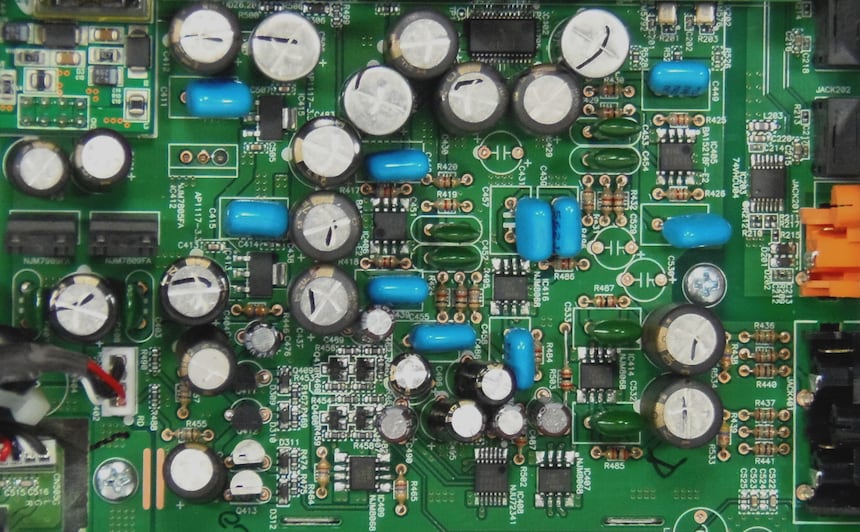
The PCM1795’s output is in a differential current mode, the current-voltage conversion is assigned to a BA15218E operational amplifier (op-amp) with low noise and low distortion, and very low noise NJM8068 op-amps filter the signals before sending them directly to the RCA outputs and through an NJM72341 integrated circuit for volume control to the headphone amplifier. This is all managed by a classic combination of an NJM8068 op-amp (which adds voltage), and output transistors (to deliver current). Denon uses additional K339 and K349 field-effect transistors (FETs) for a push-pull effect.
Listening Experience
Until now, DACs using a sample rate conversion haven’t always provided particularly rigorous fidelity, but the Advanced AL32 processing in the Denon DA-300USB is something of a pleasant surprise.
Using a piece we’ve employed to test sound quality for a while now (Henry Wood’s ‘Fantasia on British Sea Songs’) we noticed that Denon’s processing doesn’t effect timbres as we’ve seen elsewhere (they can range all over the place).
Here it’s all very clean and the instrumentation on each piece of ‘Fantasia on British Sea Songs’ retains all its richness. In fact, it almost seemed like the strings had been given a little extra finesse.
Listening to Beethoven’s ‘Concerto for Violin’ with Vera Beths on violin and the Tafelmusik ensemble conducted by Bruno Weil, confirmed our impressions regarding timbres, but also highlights a little electronic niggle in the highest notes played by the soloist, although it’s nothing serious.
We’re quibbling a bit here, and without a doubt it wouldn’t be a problem using some speakers that offer softer trebles (like our Triangle Antal Anniversary models).
The guitar was slightly more staccato than usual (EVER so slightly) but overall we got the same impressions listening to ‘The Golden Age’ from Beck’s ‘Sea Change’ album. The singer’s voice really benefits from the extra definition but it still maintains its warm timbre.
As for the headphone output, we found it had good quality sound reproduction, which was loyal and dynamic. It should also be powerful enough for the majority of low-impedance headphones.
In conclusion, Denon’s DA-300USB digital to analogue converter is a seriously well-designed piece of kit, especially with regards to the electronically isolated digital inputs. The Advanced AL32 processing seems convincing and provides quality sound output. For Denon, it’s a successful first attempt dipping their toe in the world of standalone digital to analogue convertors.
If you are a manufacturer, importer, distributor or other player in the area of quality sound and you’d like to get in touch with us feel free to send us an email at: newstech@qobuz.com